"Juno" will remain in the intermediate orbit of Jupiter
NASA's joke that "there is no Groundhog Day" on Jupiter was unsuccessful. The Yunona probe, which was supposed to conduct only two orbits at the intermediate 53-day orbit, was finally stuck on it - the other day NASA decided not to make attempts to switch to a scientific 14-day orbit. The official press release has been written so optimistically that the mission in the 53-day orbit looks almost better than originally planned. It's time to talk about what happened, what actions the mission management team had, and what we, the ordinary viewers, should do.
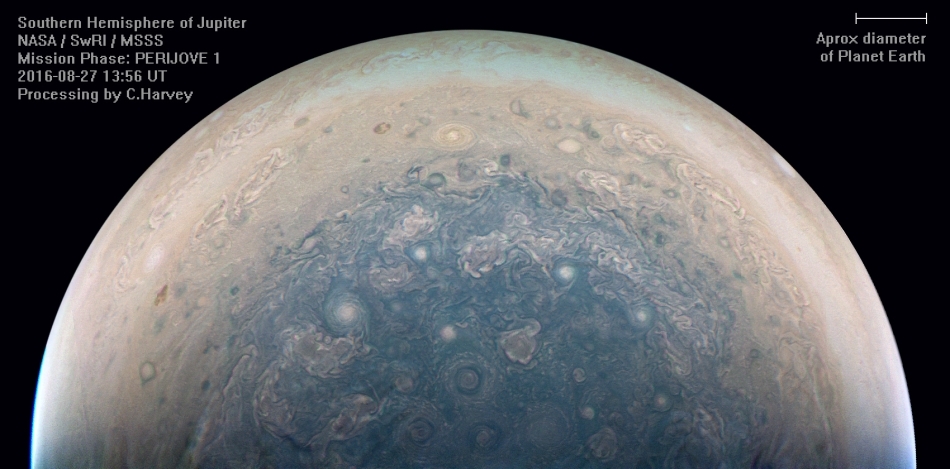
Jupiter's Southern Hemisphere, NASA Photo, C.Harvey Treatment
The “Yunona” marching engine was switched on at least three times - on two trajectory corrections in 2012 and when braking from Jupiter on July 5, 2016. And these maneuvers were held without noticeable problems. The probe successfully reached Jupiter and entered an intermediate orbit for a period of 53 days. According to the plan on October 19, he was to move to a scientific 14-day orbit. But this did not happen.

Intermediate orbits are green, scientific ones are blue. NASA image
')
On October 15, when calibrating systems before the maneuver, instead of a few seconds, helium boost valves opened for several minutes. This was enough to cancel the planned maneuver. What are these valves for? In normal operation, they open before the engine is turned on, helium presses on the membrane and provides fuel and oxidizer to the engine under constant pressure.
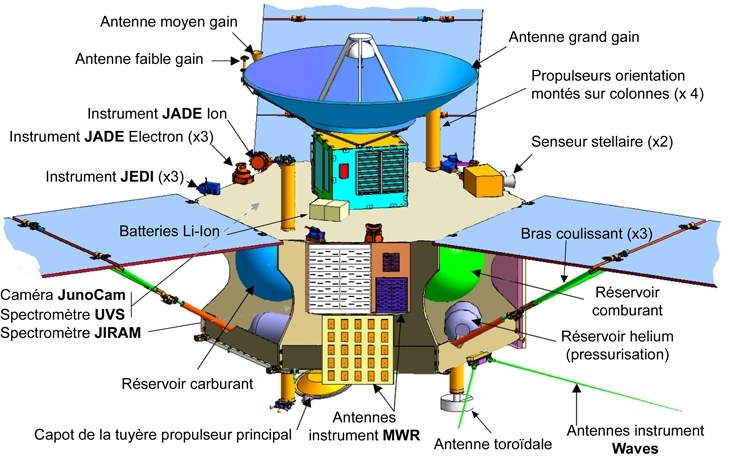
Spherical fuel tanks (blue) and oxidant (green), cylindrical helium tanks (purple)
Yunona has a special tank heating system and fuel system, which normally turns on several weeks before the maneuver and ensures that the fuel and fuel system fittings are not frozen. It is not known whether the engineers tried to warm the valves for several weeks and tried to switch them again; this option was not mentioned in an interview with representatives of the Juno team. The second way to get around the problem is to ignore the valves and turn on the engine at the pressure of the components, which is the tank now. In the process of engine operation, the pressure will drop, the reserve will not be enough for a not very long maneuver, and the relatively simple design of the engine does not have categorical prohibitions for this type of work. But the Leros-1b marching engine, which stands on Yunon, was not tested in this mode, and the MCC decided not to risk it.

Engines of the Leros family, photo of the manufacturing company Moog
On "Juno" is also a set of orientation system engines. They use only fuel, without an oxidizer, from the same tank as the sustainer engine, and are specifically designed to ensure that in the event of a complete failure of the sustainer engine to be able to reduce "Juno" from orbit and burn in Jupiter, guaranteed to avoid accidental introduction of terrestrial microorganisms on gas giant satellites. Theoretically, they can be used to move to a scientific orbit, but they are relatively weak, and the maneuver will require several turns. The fact is that in order to lower the apocenter (upper orbit point), the maneuver must be carried out in the area of the pericenter (lower orbit point), and there the speed of the vehicle is maximum, and this section of Juno flies very quickly. The final maneuver of descent from orbit into the atmosphere of Jupiter will be held in the apocenter, where the speed is minimal, and you can safely keep the engine on for hours. Despite the fundamental feasibility, this option was also not mentioned by the representatives of the mission team.
From the foregoing it follows that the PCO is most afraid of making the situation worse. The parameters of the intermediate orbit were not chosen at random, and it is quite possible to collect scientific data on it, and the transition to an unplanned orbit in the event of engine failure during maneuver may worsen the matter. The official press release even boasts that in the intermediate orbit it will be possible to collect “bonus” scientific data in remote areas that are higher than the originally planned orbit. In addition, the radiation load in the intermediate orbit is lower, which will give Juno the opportunity to work longer. But, of course, the press release emphasizes the good sides of the situation, not the bad ones. What problems will stay in intermediate orbit?
First of all, the current budget of the “Yunona” mission is calculated until July 2018, because the probe would have been burned in the atmosphere in February of the same year in a regular orbit. But in the intermediate orbit by this time it will turn out to make only 12 turns instead of the planned 36. This means either a reduction of the scientific program, or the need to extend the mission at the expense of additional funds from the NASA budget. In principle, the extension of the mission program costs a little, and the likelihood that “Juno” will be given more money is great, but, nevertheless, it is not one hundred percent.
The next problem is that the probe is solar powered. In the intermediate orbit in 2019, "Juno" will begin to fly into the shadow of Jupiter, which is completely unacceptable. Therefore, the plane of the orbit will need to be rotated. Fortunately, the maneuver does not require a large change in speed, and the orientation engines will do quite well for this task.
So, despite the refusal of attempts to bring the probe into the planned orbit, Juno has a chance to successfully complete his mission.
The main scientific instruments of "Juno" work in the invisible range and collect data, which will be expressed in boring graphs. But it’s not for nothing that NASA PR people are eating their own bread - a Junocam camera is installed on the probe, which takes beautiful pictures. Moreover, the website of the mission regularly polls which of the potentially interesting sites to shoot. I would recommend to make a note in the diaries - the next round of voting will take place from March 10 to 15 and will determine the location of the survey at the fifth rapprochement with Jupiter on March 27. According to engineers, the camera will have to work at least seven turns and break no earlier than this fall.
It is curious that on the website of the mission in one section are both the original photos, and the result of their processing, sent by enthusiasts. It seems that they take almost any job, because professionally processed photos are side by side with frivolous and even strange ones.
A fresh photo of the south pole, taken at the fourth approach to Jupiter on February 2. Processing Roman Tkachenko.

Full size photo
The Sickle of Jupiter and the shadow of Ganymede, processed by Roman Tkachenko.
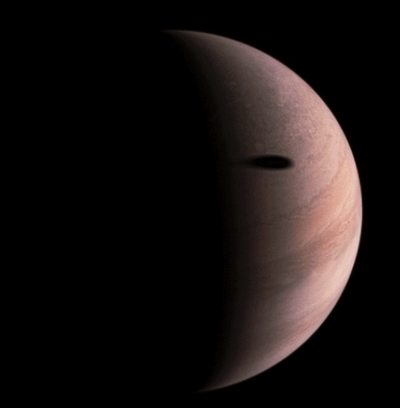
In large size
This image is processed by David W. Thomson III for a greater contrast of unusual elongated vortices.
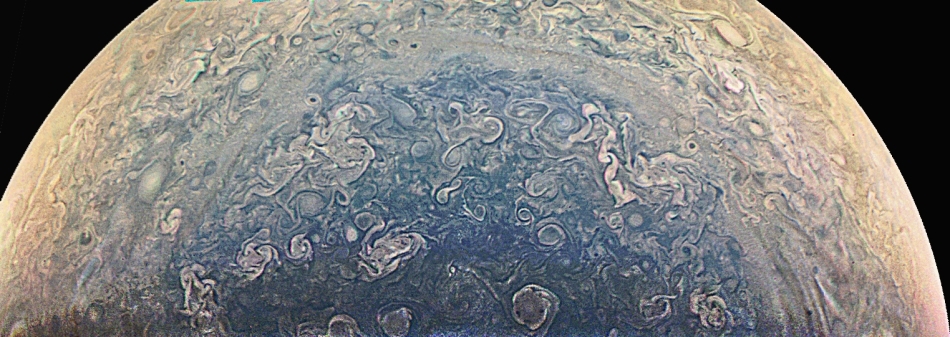
Large image
Convergence with Jupiter on February 2, in the frame of the northern hemisphere, the author of the collage Philosophia-47.
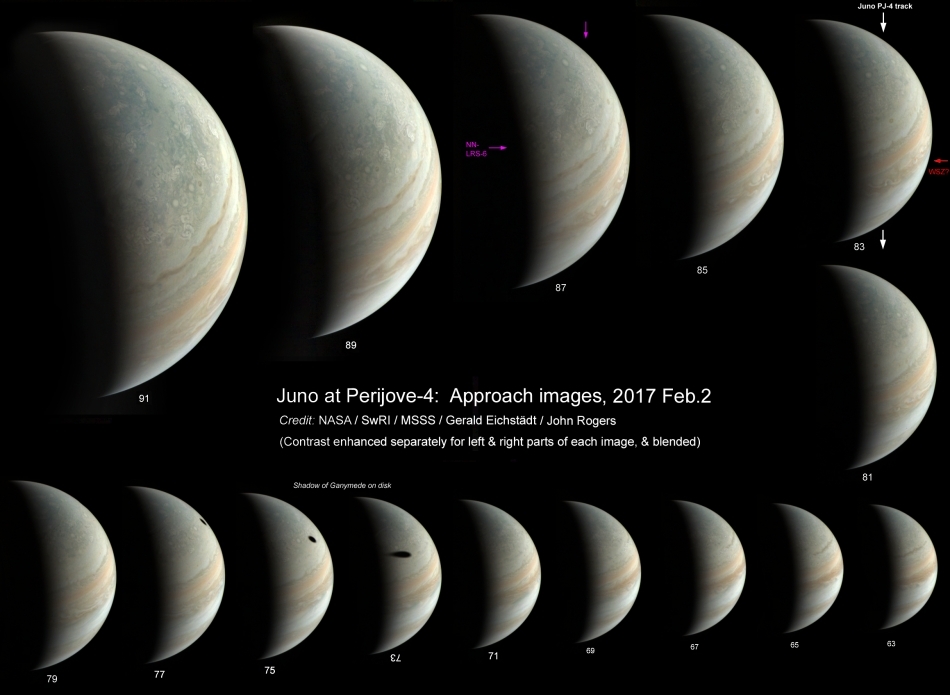
Full size image
“Jupiter Smiles at the Photo,” edited by David W. Thomson III.
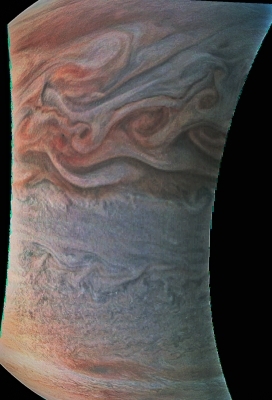
"Electric Wind", by CosmEffect.
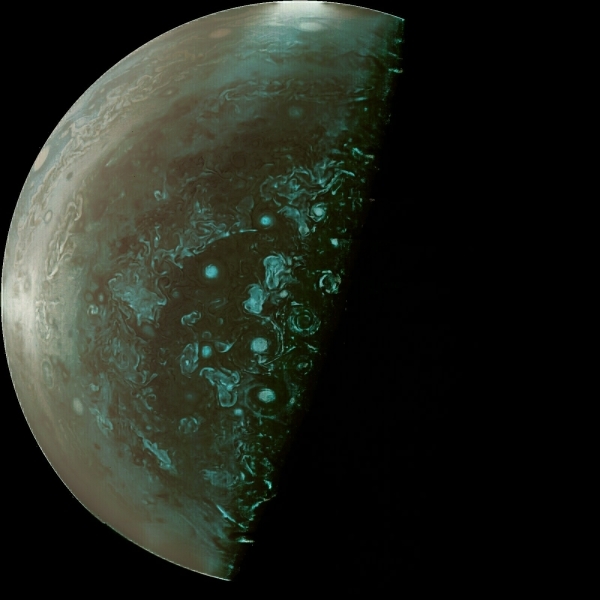
Large image
"Space Cat Meow" by Wintje (now you understand what it was all written for :))

Winter Bynes video, conceptual to the utmost, with author music.

Jupiter's Southern Hemisphere, NASA Photo, C.Harvey Treatment
Failed valves
The “Yunona” marching engine was switched on at least three times - on two trajectory corrections in 2012 and when braking from Jupiter on July 5, 2016. And these maneuvers were held without noticeable problems. The probe successfully reached Jupiter and entered an intermediate orbit for a period of 53 days. According to the plan on October 19, he was to move to a scientific 14-day orbit. But this did not happen.

Intermediate orbits are green, scientific ones are blue. NASA image
')
On October 15, when calibrating systems before the maneuver, instead of a few seconds, helium boost valves opened for several minutes. This was enough to cancel the planned maneuver. What are these valves for? In normal operation, they open before the engine is turned on, helium presses on the membrane and provides fuel and oxidizer to the engine under constant pressure.

Spherical fuel tanks (blue) and oxidant (green), cylindrical helium tanks (purple)
Yunona has a special tank heating system and fuel system, which normally turns on several weeks before the maneuver and ensures that the fuel and fuel system fittings are not frozen. It is not known whether the engineers tried to warm the valves for several weeks and tried to switch them again; this option was not mentioned in an interview with representatives of the Juno team. The second way to get around the problem is to ignore the valves and turn on the engine at the pressure of the components, which is the tank now. In the process of engine operation, the pressure will drop, the reserve will not be enough for a not very long maneuver, and the relatively simple design of the engine does not have categorical prohibitions for this type of work. But the Leros-1b marching engine, which stands on Yunon, was not tested in this mode, and the MCC decided not to risk it.

Engines of the Leros family, photo of the manufacturing company Moog
On "Juno" is also a set of orientation system engines. They use only fuel, without an oxidizer, from the same tank as the sustainer engine, and are specifically designed to ensure that in the event of a complete failure of the sustainer engine to be able to reduce "Juno" from orbit and burn in Jupiter, guaranteed to avoid accidental introduction of terrestrial microorganisms on gas giant satellites. Theoretically, they can be used to move to a scientific orbit, but they are relatively weak, and the maneuver will require several turns. The fact is that in order to lower the apocenter (upper orbit point), the maneuver must be carried out in the area of the pericenter (lower orbit point), and there the speed of the vehicle is maximum, and this section of Juno flies very quickly. The final maneuver of descent from orbit into the atmosphere of Jupiter will be held in the apocenter, where the speed is minimal, and you can safely keep the engine on for hours. Despite the fundamental feasibility, this option was also not mentioned by the representatives of the mission team.
From the foregoing it follows that the PCO is most afraid of making the situation worse. The parameters of the intermediate orbit were not chosen at random, and it is quite possible to collect scientific data on it, and the transition to an unplanned orbit in the event of engine failure during maneuver may worsen the matter. The official press release even boasts that in the intermediate orbit it will be possible to collect “bonus” scientific data in remote areas that are higher than the originally planned orbit. In addition, the radiation load in the intermediate orbit is lower, which will give Juno the opportunity to work longer. But, of course, the press release emphasizes the good sides of the situation, not the bad ones. What problems will stay in intermediate orbit?
First of all, the current budget of the “Yunona” mission is calculated until July 2018, because the probe would have been burned in the atmosphere in February of the same year in a regular orbit. But in the intermediate orbit by this time it will turn out to make only 12 turns instead of the planned 36. This means either a reduction of the scientific program, or the need to extend the mission at the expense of additional funds from the NASA budget. In principle, the extension of the mission program costs a little, and the likelihood that “Juno” will be given more money is great, but, nevertheless, it is not one hundred percent.
The next problem is that the probe is solar powered. In the intermediate orbit in 2019, "Juno" will begin to fly into the shadow of Jupiter, which is completely unacceptable. Therefore, the plane of the orbit will need to be rotated. Fortunately, the maneuver does not require a large change in speed, and the orientation engines will do quite well for this task.
So, despite the refusal of attempts to bring the probe into the planned orbit, Juno has a chance to successfully complete his mission.
What to do
The main scientific instruments of "Juno" work in the invisible range and collect data, which will be expressed in boring graphs. But it’s not for nothing that NASA PR people are eating their own bread - a Junocam camera is installed on the probe, which takes beautiful pictures. Moreover, the website of the mission regularly polls which of the potentially interesting sites to shoot. I would recommend to make a note in the diaries - the next round of voting will take place from March 10 to 15 and will determine the location of the survey at the fifth rapprochement with Jupiter on March 27. According to engineers, the camera will have to work at least seven turns and break no earlier than this fall.
It is curious that on the website of the mission in one section are both the original photos, and the result of their processing, sent by enthusiasts. It seems that they take almost any job, because professionally processed photos are side by side with frivolous and even strange ones.
A fresh photo of the south pole, taken at the fourth approach to Jupiter on February 2. Processing Roman Tkachenko.

Full size photo
The Sickle of Jupiter and the shadow of Ganymede, processed by Roman Tkachenko.

In large size
This image is processed by David W. Thomson III for a greater contrast of unusual elongated vortices.

Large image
Convergence with Jupiter on February 2, in the frame of the northern hemisphere, the author of the collage Philosophia-47.

Full size image
“Jupiter Smiles at the Photo,” edited by David W. Thomson III.

"Electric Wind", by CosmEffect.

Large image
"Space Cat Meow" by Wintje (now you understand what it was all written for :))
Winter Bynes video, conceptual to the utmost, with author music.
Source: https://habr.com/ru/post/401707/
All Articles